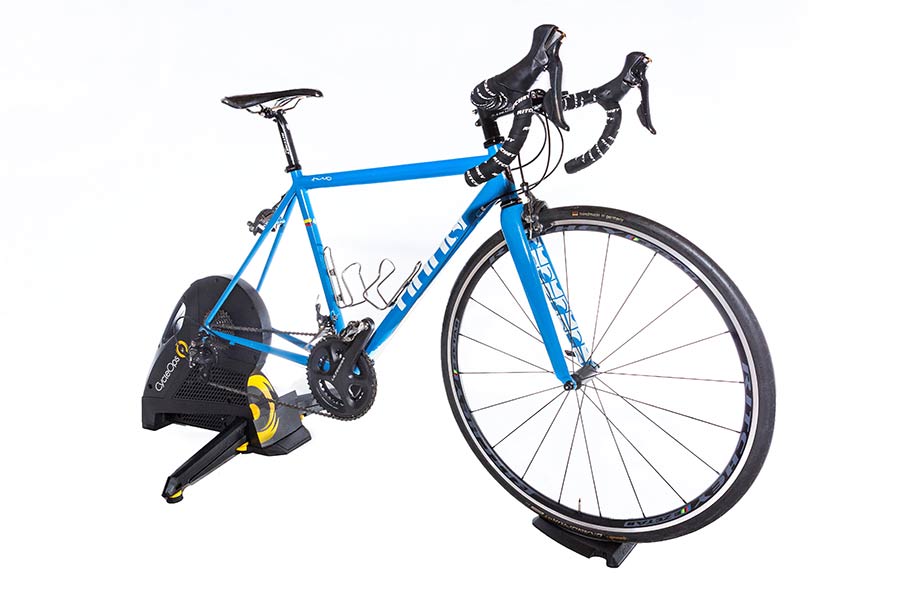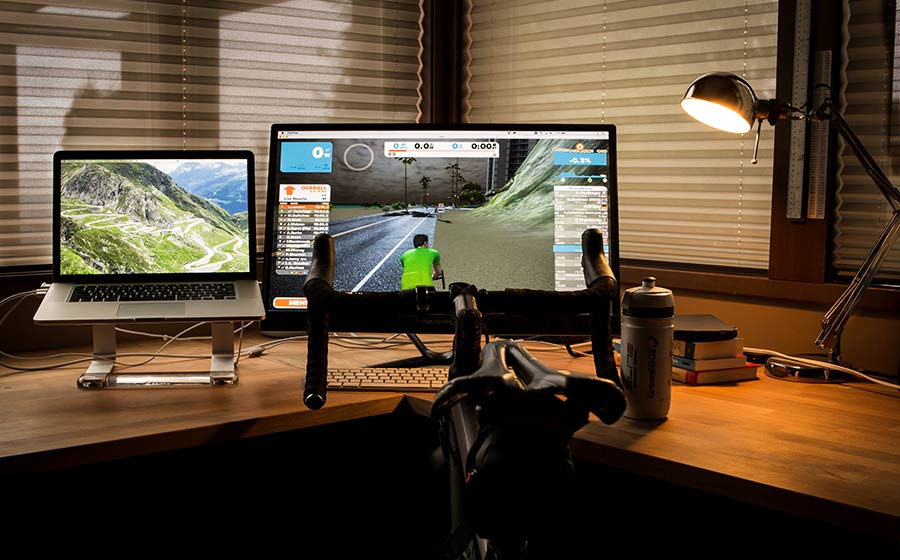By: Hans Gaitan
Prologue
When you think about smart trainers, power meters and applications like Zwift, you don't normally think about cyclists like me. Sure, I'm obsessive about my bikes, I probably own more of them than I should, and I ride a fair amount. But I don't race, and simply riding with others more or less fulfills any and all competitive desires I may have. But when ROAD Magazine gave me the opportunity to test out the CycleOps Hammer, along with a trial membership to Zwift, I have to admit that I was curious. While the thought of measuring my power, and sweating indoors while competing against strangers struck me as an unusual undertaking, I decided to give it a try. What I found in using these products was unusual. Through years of writing for different cycling publications, I've tested other products, but none ever had the profound effect that this combination did.
LeMond versus Hinault. Coppi versus Bartali. Anquetil versus Poulidor. Me versus that one food delivery guy who wanted to race me downtown last month. Cycling's history is replete with storied rivalries that prove how competitive this sport can be, and also shows how stubbornly competitive we as cyclists can be. Interestingly, however, some of the greatest examples of this very fact have little to do with racing. Consider, for example, any conversation you may have regarding riding in bad weather with a fellow cyclist. Unless you are speaking to long-time residents of places like Florida or Southern California, you'll likely end up talking about the worst weather you've ever ridden in, and the coldest temperatures that you're willing to go out in. 30 degrees with freezing rain. 20 degrees with light snow. Single digits. Minus three. Whatever you end up saying, someone in the room will scoff at your weakness when it comes to weather. That's because, as it turns out, there are some cyclists who will simply think less of you unless you are willing to ride submerged in a pool of liquid nitrogen.
Why do I tell you this? Because it's true, but also as a disclaimer and acknowledgement that what I consider to be "cold, wet and miserable" could well be your idea of a pleasant ride in nice weather. Be that as it may, my story is one that many if you are likely familiar with (just with different data points). Simply put, I found my limit in terms of what weather I'm willing to ride in. But luckily, I also found a solution. 
Moving
Two years ago, my wife and I moved from Pittsburgh, Pennsylvania, to Seattle, Washington. During my time in Pittsburgh, winters were harsh (by my standards), but as long as roads were fairly clear of ice and snow, I was able to commute and ride on weekends into the upper teens. In fact, I found that sunny days in the mid 20s were surprisingly comfortable to ride in, with the proper attire. Icy roads, low teens or single digits were my limit. Nature's way of telling me to stay indoors and ride some other day.
Upon moving to Seattle, I assumed that due to warmer winters, and almost complete lack of snow, I would be riding lots more year round. Oh, how wrong I was, for it was here that I met my match. Low 40s and rain, it turns out, is my cycling kryptonite. And in Seattle, this kind of kryptonite is very common during winter months. That, along with shorter days greatly cut down on my ability to ride, which in turn began to affect my mood dramatically. So much so that I considered doing something drastic. Something unthinkable that I never thought I'd turn to. Getting an indoor trainer. 
Guy Fieri
I've tried indoor trainers three times in the past. Each time motivated by some new feature or technology that is supposed to make the act of riding your bike indoors less soul-crushing that it actually is. I was never able to put up with it, much less enjoy it. I tried fancy fluid trainers, which felt decent but were loud and bored me to tears. I tried riding with the help of music, movies and then DVDs where a nice man in pleated khaki shorts named Coach Troy told me how fast to pedal and for how long. Despite Coach Troy's enthusiasm, I could never get used to riding indoors. Later on, I also tried an early iteration of a smart trainer. It didn't have a flywheel, and riding a bike connected to that torture device was akin to getting a pedal-driven steamroller going. Making matters worse, the proprietary software it connected to was buggy. It lost connection often, and power readings varied as widely as my teenage nephew's mood (and that's saying a lot, because he's a very, very moody kid).
Details aside, what bugged me the most was that these trainers in no way connected with that part of my brain that likes riding a bicycle outdoors. So riding on a trainer in my living room felt a bit like being hungry, and instead of eating actual food, being forced to watch a marathon of Guy Fieri's TV show Diners, Drive-Ins and Dives. That show deals with food, but it wont fill you up. Likewise, being on a trainer had me on a bike, and that seemed like a step in the right direction. But that was about the extent of it. The monotony, like Guy Fieri's bleached soul patch, was unbearable.
And yet, as another dreary, cold Seattle Saturday was upon me, I broke down and decided to look into a smart trainer yet again. As I understood it, technology had come a long way. Trainers, particularly smart and direct drive ones, were supposedly better. Plus, software like Zwift was getting rave reviews from people I knew, with one friend in particular referring to it as “transformative”.
Perhaps, I thought, riding an indoor trainer these days could actually be less like staring at Guy Fieri's face for hours upon hours. Had things actually changed enough to get me through this winter riding indoors some of the time? I had to find out. 
Set-Up and First Impressions
Considering the apparent complexity of what smart trainers are capable of, I was amazed by how simple and pleasant setting up the CycleOps Hammer was. The physical setup was easy, and I was elated to see just how tiny the instructions booklet was. Always a good sign. For the first bike I tried on the trainer, a disc-equipped BMC with a 135mm rear hub, I had to swap out one of the two cups on the trainer where the rear dropouts sit. A simple procedure requiring a 5mm hex key. At first, I was concerned that my rear brake (a TRP Spyre) was very close to touching the unit. But once the dropouts were seated properly, even under hard efforts, the brakes never came in contact with the Hammer.
Likewise, Zwift was easy to set-up. In fact, in all of 15 minutes, I was ready to ride with Zwift running smoothly on my Apple MacBook. Interestingly, while I was instantly wowed by all the technology in front of me, the first thing I noticed about my set-up was how simple it all seemed. I never had to think about the software, connectivity between the unit and my computer, or anything of the sort. Much in that way that a saddle that suits you is one you stop thinking about, the set-up simply worked. I was left to ride my bike.
The CycleOps Hammer, being a direct drive trainer (meaning that you take off the rear wheel, and your chain connects directly to the trainer through a user-provided cassette), is much, much quieter than any fluid trainer I have tried in the past. Because of that, I quickly realized that noise was a pet peeve of mine with indoor trainers. So I instantly appreciated the lower volume level of the Hammer (as did my wife and our dog). This also helped me forget what I was doing, namely riding a bike indoors. Likewise, the massive 20-pound flywheel made this trainer feel unlike any I had tried in the past. Far more realistic. Additionally, small details like the retractable arms and handle on the Hammer made me realize that indoor trainer makers were finally paying attention to details that had been neglected in the past. I mean, how on earth did so many trainers not even have handles before? How come our need to store them away from time to time, or even carry trainers hadn't been taken into account before?
The relative portability of the Hammer meant that I was able to move it around more easily. This, along with Zwift's app, which ran effortlessly on my iPad mini, allowed me to use them both in different places around the house. When my wife had friends over, and they needed the living room (where I used an Apple TV to show the Zwift app on our TV screen), I simply retreated to the garage.
At this point of the review, I should be giving you, the reader, lots of technical details about the trainer's performance. Instead I'm talking about portability and ease of storage. Oh, and about the Hammer's handle. But honestly, when riding this trainer you simply forget about the actual unit. It gets out of the way, and does it's job marvelously well. So the fact that I'm focusing on its handle, and other ancillary aspects of its design is perhaps the greatest compliment I could give the CycleOps Hammer. 
Digging a Little Deeper
My past experience with software and smart trainers made me cautious about Zwift, even after the initial set-up went smoothly. But the difference between it, and the buggy messes I had deal with before were instantly obvious. For other users, the allure of Zwift might be the gamefication of riding indoors. Not for me. In fact, the gamefication of riding outdoors (aka racing) is also of no interest to me. Perhaps that's because I never even made it to the second level in Pac-Man. And no, I'm not exaggerating for effect. The total combined amount of time I've spent playing video games of any kind in my life (before Zwift, at least) is probably less than ten minutes. A rarity for a male my age.
For me, the application's appeal lays elsewhere. But I can't fully place it. Except to say that it effectively replicates something about real riding that I had missed before when riding on a trainer. Perhaps it's the random shifts in difficulty that come with riding a bike outdoors, along with giving something interesting to look at (sorry, binge watching episodes of Homeland while on the trainer never worked for me). Could that be it? I mean, I was suddenly interested in what was around the virtual bend, knowing that it would affect the effort I'd have to make. Just like in real life. But oddly enough, data like watts and heart rate, gained meaning, and later became interesting as well. I realized that things I did or watched while on the trainer before were trying to distract me from what I was doing. They were merely my attempts to drown out the experience and its monotony. Zwift, on the other hand, was putting me further into the experience, without denying what I was up to, but rather celebrating it.
While at first, I would simply go on aimless rides lasting around an hour, happy to just be spinning my legs during an afternoon of dreadful weather, I soon began to dig deeper. Rides got longer, and 45-minute workouts became a favorite lunchtime activity of mine. For whatever reason, even as a non-racer and non-gamer, I loved getting little gold stars for my efforts. So maybe gamification did have an effect on me after all.
Later I found myself joining group rides, while I had previously assumed that the social aspect of the software was of no real interest to me. I slowly started to realize that while I had started out looking for a way to hate riding indoors less, I had actually ended up finding a solution that made me like new things about riding indoors. Weird. And through this process, the actual indoor trainer became a transparent, seemingly unimportant part of the equation. Though of course, I understand that its apparent unimportance actually speaks volumes about its quality. Weirder still.
As a point of comparison, I also used CycleOps' own Virtual Training software. It costs $15 a month (Zwift is $10, neither require a year-long contract), and offers a slightly different experience. While its interface is a bit less intuitive than Zwift, Virtual Training is not available for Apple computers, but does run very well in iPads. My favorite part of VirtualTraining was the option to “ride” on routes in Google Maps, especially those that users had uploaded bike-mounted videos for. Resistance on the trainer increased and decreased according to the terrain, and the speed of the video shown also reacted to my pedaling. I could see this being an amazing tool for people preparing for a certain event, race or anything of the sort. In the end, I gravitated more toward Zwift, but this is probably just a personal choice, and VirtualTraining could very well appeal to some readers. Luckily, both have free trials that are well worth taking advantage of. 
Summer is Coming
As the cold and dreary weather slowly starts to break, and spring arrives in the Pacific Northwest, I've admittedly started to wonder what place, if any, the CycleOps Hammer and Zwift will have in my life during the rest of the year. Given the chance to ride outdoors for 5 hours, even in weather that is only slightly better than iffy, I'll probably always choose to ride outdoors. But lunchtime workouts indoors have become part of my routine. So have nighttime rides, and the occasional race on Zwift. It's not a binary, either-or matter for me anymore. I enjoy both, just differently. And while I still don't really care about earning the ability to wear a new jersey or have new wheels on my virtual bike on Zwift, the fact that I'm riding indoors this often is, as my friend put it, transformative.
Perhaps the greatest testament to how well this combination works is that, much in the way that I've never thought of riding my bike outdoors as exercising, I don't think of using an indoor trainer now as torture. To contrary, I actually like it. Which means that the next time I come across that delivery guy, the one who wanted to race a couple of months ago, I'll take him up on it. With all these lunchtime workouts in legs, I don't think he stands a chance.

Hans was born and raised in Bogotá, Colombia, where he started waking up before dawn to listen to radio transmissions of the Tour de France and the Giro d’Italia in 1984.
He currently lives in Seattle, Washington, where he rides his bike outside when it’s nice out, and writes about cycling for both American and European publications.
